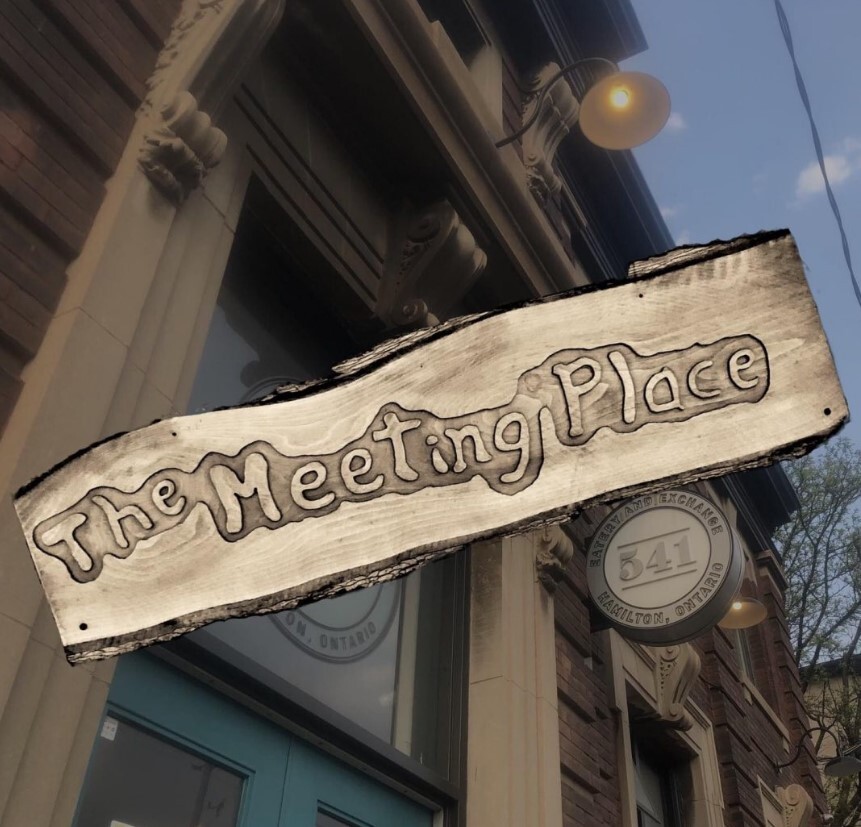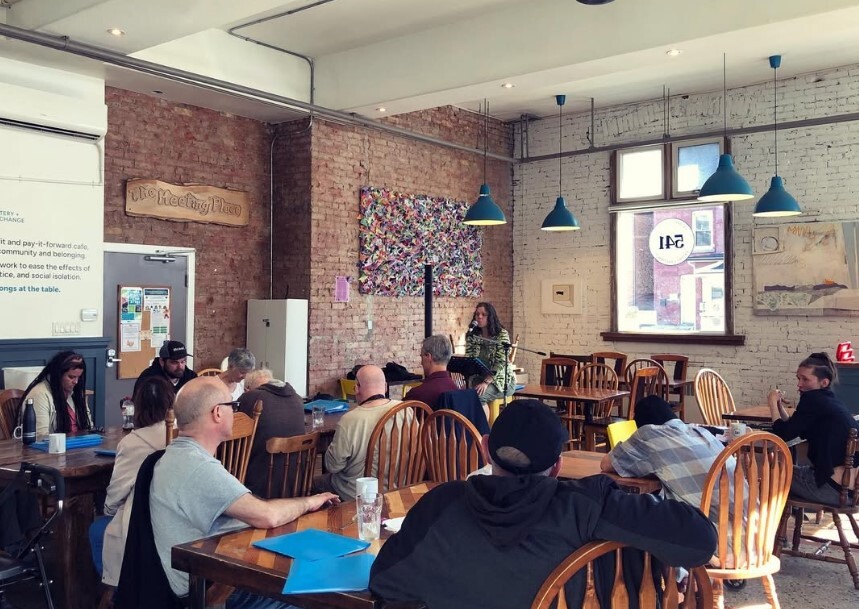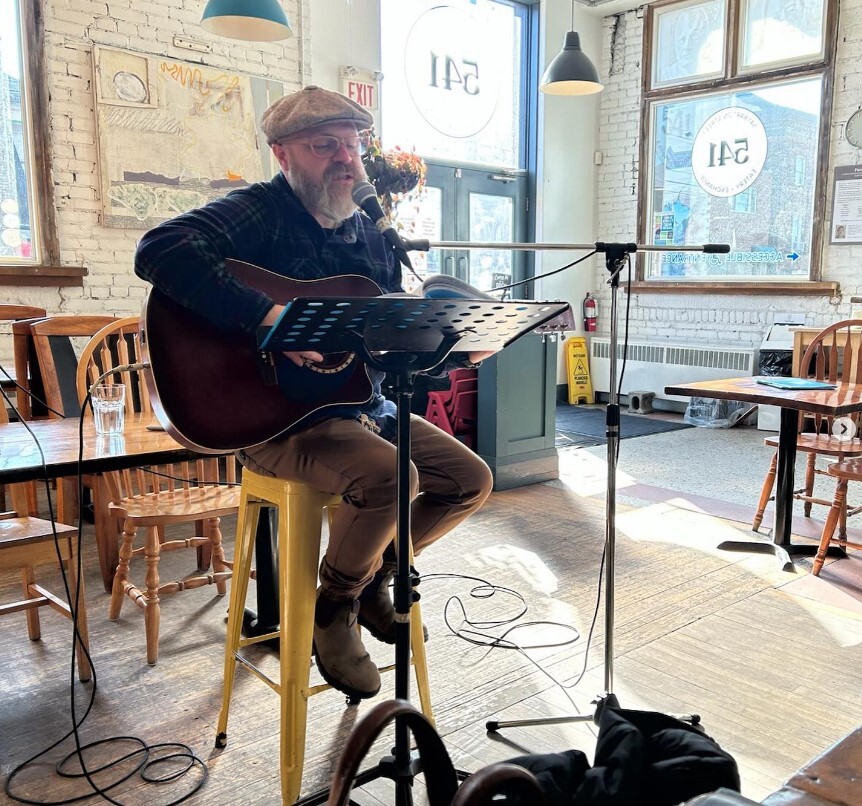The Meeting Place: A Church for All
May 21st

This wooden sign has watched over gathering of The Meeting Place for nearly 20 years.
A Humble Beginning
For over 20 years, a small group has gathered in downtown Hamilton at The Meeting Place. They worship together in word and song, pray for each other and break bread. Some weeks only three or four individuals may come and sometime 20 or 30 are present. Everyone is welcome here.
Sue Carr and Randell (Randy) Neudorf are the leaders of this community. It started when Sue was working as the chaplain at the Mission Services men’s shelter in downtown Hamilton in 2005. In her work with the men who stayed there, she was asked to begin a chapel service on Sundays. She got permission to use a small backroom to have a service on Sundays and began with a group of three people. The room had an exterior door, so passers-by would look through and see the gathering. Some of those who looked in wanted to join, so word of the group spread and more individuals began to come. Soon the small room was full wall-to-wall with worshipers every Sunday. These worship services were without a name until one day someone brought a large wooden sign with “The Meeting Place” carved into it. The name resonated with the community, and that has been their title ever since.
“Sunday after Sunday I knew why I was there - and the people came.”
Not a Church—But a Community
“I only ever thought of it as a chapel, because if it was a church I would be a pastor, and that wasn’t what I wanted as a job.” Sue said, “I told the people, we can practice being a church so that you can go join a real church, but people never left!”
 A few years later, Sue was asked to take on a role as the director of the 541 Eatery and Exchange, a community coffeehouse in Hamilton. As a condition on taking the job, she asked that the coffeehouse begin hosting The Meeting Place on Sundays. This brought the church to a new home, and they have been meeting there on Sunday afternoons since. Meeting in the afternoon lets attendees perhaps attend a different church in the morning or access public services at other places.
A few years later, Sue was asked to take on a role as the director of the 541 Eatery and Exchange, a community coffeehouse in Hamilton. As a condition on taking the job, she asked that the coffeehouse begin hosting The Meeting Place on Sundays. This brought the church to a new home, and they have been meeting there on Sunday afternoons since. Meeting in the afternoon lets attendees perhaps attend a different church in the morning or access public services at other places.
“We have our service at 4:00 because we don’t want people to have to chose between what helps them in community.” Randy said, “If someone has a morning church, or an afternoon chapel or meal program, we want them to have as many circles of community as they can have. It just made sense to have church in the afternoon.”
Randy became involved in 2022. He started attending infrequently while looking for a new church to join. He was occasionally asked to lead music and began providing leadership in prayer. He was drawn to the church because of its support for all its attendees. The people of the church were open and willing to provide prayer, support and community to meet each other’s needs. He describes it as “a place that shows up for whoever is in the room.” Today he is the music director and community outreach worker for the community.
A Sunday Worship
A Sunday afternoon at The Meeting Place begins with hot drinks, followed by singing. Randy leads music from blue duotangs of song lyrics or hymn sheets. Sometimes, people call out songs they want to sing, ranging from classic hymns to Bob Dylan or Johnny Cash. Occasionally they pause between songs to discuss the meaning of a particular song as they worship together.
“We discuss how to pray and what it means. Praying for food and shelter is important but so is praying to understand God more deeply.”
After the singing, the community prays together. They participate in the 24-7 prayer movement, an international, interdenominational approach focused on continuous prayer for each other and the world. Often, they follow an ACTS format, Adoration, Confession, Thanksgiving and Supplication, as they pray out-loud, and sometimes privately and personally.
“Our folks often haven’t gone to church since they grew up, prayer can be a weird thing for them.” Sue says, “We discuss how to pray and what it means. Praying for food and shelter is important but so is praying to understand God more deeply.”
The third part of the service is the teaching time. It can resemble a traditional sermon or can also be a more open discussion on a Bible passage or questions of faith. Listeners are welcome to shout out questions or share their own experiences. They have communion once a month and, on those Sundays, they experiment with different prayer practices, perhaps Visio Divina, or breath prayers or praying while creating visual art. After the service the community shares a light meal together.
Weathering the Storm: Impact of the Pandemic
The Covid-19 pandemic had a significant impact on the Meeting Place. With restrictions and lockdowns really changing the rules on gatherings, their community was heavily affected. Like many congregations they met online, however many of their regulars did not have consistent access to devices to attend Zoom worship. In 2022, they started gathering in-person again with a very small group. Somewhere between four to ten people would be seen at each gathering. This year, they have seen the community growing, with around 20 individuals coming to their services.
Community and Gifts
Recent growth has come from rebuilding connections around the 541 Coffeehouse and with the local community. Last year, Randy and Sue began a conversation with MCEC about supporting outreach around The Meeting Place, working with MCEC Mission Minister Norm Dyck. This coincided with the decision of another MCEC congregation, Agape Fellowship in London, to close their doors. In deciding how to use their remaining financial resources, the Agape community wanted to support urban mission work similar to the kind of work they had down in London. They agreed to use their remaining resources to fund an outreach worker for The Meeting Place.

Randy leading music
With this support, Randy has expanded his work to intentionally be in the coffeehouse on Thursday afternoon.. He can be present to provide pastoral care, community prayer, to have conversations and build relationships with others in the community.
Randy describes “This work has been really good, we are still building connections, but it felt like this was the right time to be in the coffeehouse more. Sometimes none of our regulars are around but I’ll overhear a conversation or meet someone in crisis, and I can be in a position to offer to pray with them.”
Both Sue and Randy expressed their thanks to the Agape community for providing the resources to support this ministry.
“After COVID, when there were only five of us, I began to wonder if this was naturally coming to an end. But I never felt an answer of yes.” Sue explained, “Sunday after Sunday I knew why I was there - and the people came.”